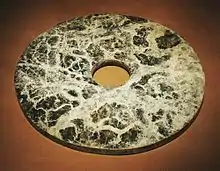40th century BC
During the 40th century BC, the Eastern Mediterranean region was in the Chalcolithic period (Copper Age), transitional between the Stone and the Bronze Ages. Northwestern Europe was in the Neolithic. China was dominated by the Neolithic Yangshao culture. The Americas were in a phase of transition between the Paleo-Indian (Lithic) to the Meso-Indian (Archaic) stage. This century started in 4000 BC and ended in 3901 BC.
| Millennium: | 4th millennium BC |
|---|---|
| Centuries: |
|
| Timelines: |
|
| State leaders: |
|
| Decades: |
|
| Categories: | Births – Deaths Establishments – Disestablishments |
Cultures
- Near East
- In Predynastic Egypt, the El Omari culture arose during this period[1]
- Start of the Naqada culture in Egypt[2]
- In Mesopotamia, the Uruk period began[3]
- The Linear Pottery culture gives way to the Funnelbeaker culture in the north
- Cucuteni–Trypillian culture
- Pit–Comb Ware culture
- In the Pontic steppe, the Dnieper–Donets and Sredny Stog cultures flourish, according to the Kurgan hypothesis associated with Proto-Indo-Europeans
- East Asia
- Liangzhu culture
- Early Jōmon period begins on the islands of Japan
Events and innovations

Jade bi from the Liangzhu culture. The ritual object is a symbol of wealth and military power.
- 5.9-kiloyear event
- c. 4000 BC, more than 100 dwellings surrounding a community center, a cemetery and a kiln are built in Jiangzhai, near modern Xi'an, China
- Susa is a center of pottery production; c. potter's wheel in Mesopotamia[4]
- Approximate time of the construction of the Merheleva Ridge complex
- Megalithic monuments are constructed in Brittany (Carnac), Portugal (Lisbon), central and southern France, Corsica and Great Britain
- Metallurgy during the Copper Age in Europe
- Domestication of the horse
- Plough in use
- Clay pots and vats discovered at a sprawling cave system in southern Armenia near the border with Iran shows signs of an organized effort to press and distill grapes[5]
Calendars
- Bede began his history of the world with 3952 BC
- In their ceremonial or commemorative proceedings, Freemasons add 4,000 years to the current Anno Domini calendar year and append Anno Lucis ("Year of Light") to the year (i.e., 2020 AD = 6020 AL). This alternative calendar era, which would designate 4000 BC as "year zero", was created in the 18th century (58th century AL) in deference to the Hebrew calendar's Anno mundi and other ideas regarding the year of creation at the time.
References
- Fagan, Brian (1996). The Oxford Companion to Archaeology. Oxford University Press. p. 194. ISBN 0195076184. Retrieved 6 December 2016.
- "Naqadan Culture". Ancient Egypt Online. Retrieved 6 December 2016.
- Mark, Joshua. "Uruk". Ancient History Encyclopedia. Retrieved 6 December 2016.
- Federico Lara Peinado, Universidad Complutense de Madrid: "La Civilización Sumeria". Historia 16, 1999.
- Walker, Brian. "Scientists discover 'oldest' winery in Armenian cave". CNN. CNN. Retrieved 6 December 2016.
This article is issued from Wikipedia. The text is licensed under Creative Commons - Attribution - Sharealike. Additional terms may apply for the media files.